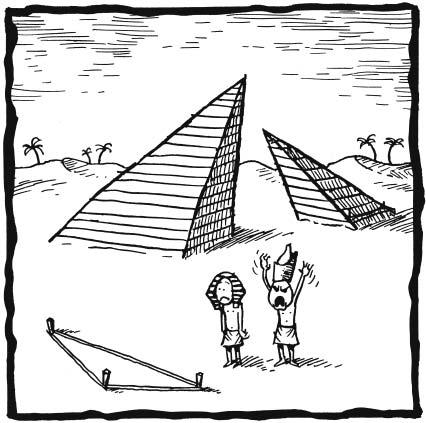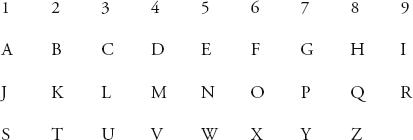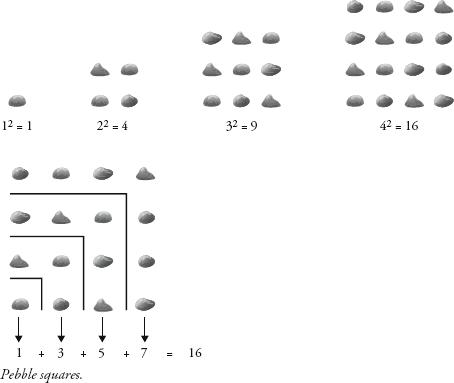Alex’s Adventures in Numberland (12 page)
Read Alex’s Adventures in Numberland Online
Authors: Alex Bellos

Miyamoto met his wife, a former national
soroban
champion, when they frequented the same abacus club as youngsters. Their daughter, Rikako, is a
soroban
prodigy. Pity her if she wasn’t. At age eight, she completed her top dan – a level that only one in 100,000 people ever achieve in their lifetimes. Rikako, who is now aged nine, was in class. She was wearing a pastel-blue top, and her fringe came down to her glasses. She looked very alert and pursed her lips as a sign of concentration.
Shiritori
is a Japanese word game that starts with a person saying
shiritori
and each subsequent person must say a word that starts with the last syllable of the previous word. So, a possible second word would be
ringo
(apple), because it begins with
ri
. Miyamoto asked Rikako and the girl next to her to play
shiritori
with each other at the same time as playing a game of
Flash Anzan
in which 30 three-digit numbers were to be displayed in 20 seconds. The machine sounded its introductory pips and the girls’ dialogue went:
Ringo
Gorira
(gorilla)Rappa
(trumpet)Panda
(panda bear)Dachou
(ostrich)Ushi
(cow)Shika
(deer)Karasu
(crow)Suzume
(sparrow)Medaka
(killifish)Kame
(turtle)Medama yaki
(fried egg)
At the end of the 20 seconds, Rikako said: 17,602. She had been able to add up the 30 numbers and play
shiritori
simultaneously.

I do not consider my birth date an especially riveting conversational opener. That may be, however, because I have not spent enough time in the company of men like Jerome Carter. I had just sat down for lunch with him and his wife Pamela at their home in Scottsdale, Arizona, when it came out: 22 November.
‘Waaaooooooow!’ said Pamela, a 57-year-old former air stewardess, who was wearing a pretty pink top and a denim skirt.
Jerome looked at me. In a serious tone he confirmed her enthusiasm: ‘You have got a very good number there.’
Jerome, who is aged 53, does not look like your average mystic. He was dressed in an orange Hawaiian shirt and white shorts, his strong frame reflecting previous careers as a karate champion and international bodyguard. So what was so good about 22/11, I asked?
‘Well, 22 is a master number. So is 11. There are only four master numbers: 11, 22, 33 and 44.’
Jerome has a distinguished face, with strong smile lines and a shiny bald dome. He also has a wonderfully musical voice, part sports commentator, part rapping MC: ‘You were born on the twenty-second,’ he said. ‘It is no accident that our first president was born on the twenty-second. Two and two equals what? Four. We elect our presidents when? Every four years. We pay our taxes in the fourth month. Everything in the United States is four. Everything. Our first navy had 13 ships, 1 and 3 equals 4. We used to have 13 colonies, 1 and 3 equals 4. There were 13 signers of the Declaration of Independence. Four. Where were they standing at? 1300 Locust Street. Four!
‘Number four controls money. You were born under it. It’s a very powerful number. The number four is the square, so it involves law, structure, government, organization, journalism, construction.’
He was beginning to hit his stride: ‘That’s how I told O.J. he was going to walk. I looked at his lawyers. All of his lawyers were born under the number four. Johnny Cochran, born on the twenty-second, 2 and 2 equals 4. F. Lee Bailey, born on the thirteenth. 1 and 3 equals 4. Barry Scheck, born on the fourth. Robert Shapiro, born on the thirty-first, 3 and 1 equals 4. He had four lawyers born under the number four. The verdict came down when? Four p.m. OK? Hitler would have walked!
‘As Mike Tyson said when I did his numbers, when it’s the time with these numbers, even your mistakes turn out good.’
Jerome is a professional numerologist. He believes numbers express
qualities
, not just
quantities
. His gift, he said, is that he can use this understanding to gather insights about people’s personalities and even predict the future. Actors, musicians, athletes and corporations pay good money for his advice. ‘Most numerologists are poor. Most psychics are poor,’ he said. ‘Which makes no sense.’ Jerome, on the other hand, lives in a beautiful home in a luxury condo with thee $25,000 motorbikes in the garage.
Birth dates are an obvious source of numbers from which to derive character traits. So are names, since words can be broken down into letters each assigned a number value. ‘Puff Daddy was about to go to jail,’ he said. ‘Puff Daddy had bad relationships. I changed his name to P. Diddy. Then when he wanted to settle down, I changed his name to – Diddy. These were my suggestions and he took them. Jay-Z wanted to marry Beyoncé. I told him he needs to go back to his original name. He went back to Shawn Carter.’
I asked Jerome if he had any recommendations for me.
‘What’s your full name?’ he said.
‘Alexander Bellos, but everyone calls me Alex.’
‘What a bummer.’ He paused for dramatic effect.
‘Is Alexander better?’ I asked.
He boomed: ‘Let us just say that one of the greatest men that walked this Earth was not called Alex the Great.
‘I’m just telling you. I have talked to people named Alex before. Just on a simple basis: the first letter of the name is very important. “A’ is 1. You’ve already got that with Alex. But with Alexander you end with an “r”. “R” equals 9. So the first and the last letters of your name are 1 and 9. Alpha and omega. The beginning and ending. Now let’s take the first and the last letter of Alex. Just the sound of “x”.’ He pronounced it ‘ekkss’ with a grimace that looked like he was about to vomit. ‘Do you want to use that? I wouldn’t. I would never go by Alex.
‘God said a good name is rather to be chosen than riches of gold! He didn’t say a nickname is rather to be chosen!’
‘Alex is not a nickname,’ I protested. ‘It’s an abbreviation.’
‘Why are you fighting it, Alexander?’
Jerome then asked for my pad and scribbled out the following table:

This, he explained, showed which numbers corresponded to which letters. He took his fingers to the first column: ‘Letters that equal one are A, J, S. Allah, Jehovah, Jesus, Saviour, Salvation. Two is the number of diplomats, ambassadors. Two gives good advice, two you love, you’re a team player, that’s B, K and T, that’s why if you go to a Burger King you can have it your way. Number three controls radio, TV, entertainment and numerology. C, L, U. Of course, you go into radio and television, you don’t have a clue.’ He gave me an ironic wink. ‘But if you learn numerology, it will open you up to the clue of life. Number four: D, M, V. How many wheels on a car? Where do you get the licence? The Department of Motor Vehicles. Five is halfway between 1 and 10: E, N and W. Five is the number of change. If you scramble the letters you get ‘new’. Six is the number of Venus, love, family, community. When you see a beautiful woman, what do you see? A FOX. Seven is the number of spirituality. Jesus was born on the twenty-fifth, 2 and 5 equals 7. Eight is the number of business, finance, commerce, money. Where do you keep the money? In the headquarters. Nine is the only one that has two letters. I and R. You ever talked to a Jamaican? Everythg is irie, man.’
On conclusion he put down his pen and looked me full in the face: ‘This,’ he said, ‘is Jerome Carter’s method of the Pythagorean system.’
Pythagoras is the most famous name in mathematics, entirely due to his theorem about triangles. (More about that later.) He is credited with other contributions, though, such as the discovery of ‘square numbers’. Imagine, as was common practice, counting with pebbles. (The Latin for pebble is
calculus
, which explains the origin of the word ‘calculate’.) When you make a square array in which pebbles are placed equally apart in rows and columns, a two-row/ column square requires four pebbles, and a three-row/column square requires nine. In other words, multiplying the number
n
by itself is equivalent to working out the number of pebbles in a square array with
n
rows and columns. The idea is so instinctive that the term ‘square’ to describe self-multiplication has stuck.
Pythagoras observed some excellent patterns in his squares. He saw that the number of pebbles used in the 2 square, 4, was the sum of 1 and 3, while the number used in the 3 square, 9, was the sum of 1 and 3 and 5. The 4 square has 16 pebbles – or, 1 + 3 + 5 + 7. In other words, the square of the number
n
is the sum of the first
n
odd numbers. This can be seen by looking at how you construct a pebble square:

Another pattern Pythagoras discovered relates to music. One day, according to legend, as he walked past a smithy and heard clinking hammer sounds coming from inside, he noticed that the pitch of the clinking changed depending on the weights of the anvils. This provoked him to investigate the relationship between the pitch of a vibrating string and its length. This in turn led him to the realization that if the length of a string is halved, the pitch increases by an octave. Other harmonies occur when the string is divided in the ratios 3:2 and 4:3, and so on.
Pythagoras was entranced by the numerical patterns he found in nature, believing that the secrets of the universe could be understood only through mathematics. Yet rather than seeing maths merely as a tool to describe nature, he saw numbers as somehow the essence of nature – and he tutored his flock to revere them. For Pythagoras was not just a scholar. He was the charismatic leader of a mystical sect devoted to philosophical and mathematical contemplation, the Pythagorean Brotherhood, which was a combination of health farm, boot camp and ashram. Disciples had to obey strict rules, such as never urinating towards the sun, never marrying a woman who wears gold jewellery, and never passing an ass lying in the street. So select was the group that those wishing to join the Brotherhood had to go through a five-year probationary period, during which they were allowed to see Pythagoras only from behind a curtain.
In the Pythagorean spiritual cosmos, ten was divine not for any reason to do with fingers or toes, but because it was the sum of the first four numbers (1 + 2 + 3 + 4 = 10), each of which symbolized one of the four elements: fire, air, water and earth. The number 2 was female, 3 was male, and 5 – their union – was sacred. The crest of the Brotherhood was the pentagram, or five-pointed star. While the idea of worshipping numbers may now seem bizarre, it perhaps reflects the scale of wonderment at the discovery of the first fragments of abstract mathematical knowledge. The excitement of learning that there is order in nature, when previously you were not aware that there was any at all, must have felt like a religious awakening.
Pythagoras’s spiritual teachings were more than just numerological. They included a belief in reincarnation, and he was probably a vegetarian. In fact, his dietary requirements have been hotly debated for more than 2000 years. The Brotherhood famously forbade ingestion of the small, round, black fava bean, and one account of Pythagoras’s death has him fleeing attackers when he came to a field of fava beans. As the story goes, he preferred to be captured and killed rather than tread on them. The reason the beans were sacred, according to one ancient source, was that they sprouted from the same primordial muck as humans did. Pythagoras had proved this by showing that if you chew up a bean, crush it with your teeth, and then put it for a short while in the sun, it will begin to smell like semen. A more recent hypothesis was that the Brotherhood was just a colony for those with hereditary fava-bean allergies.
Pythagoras lived in the sixth century
BC
. He did not write any books. All we know about him was written many years after he died. Though the Brotherhood was lampooned in ancient Athenian comic theatre, by the beginning of the Christian Era Pythagoras himself was seen in a rather favourable light, viewed as being a unique genius; his mathematical insights making him the intellectual forefather of the great Greek philosophers. Miracles were attributed to him, and some authors, rather oddly, claimed that he had a thigh made of gold. Others wrote that he once walked across a river, and the river called out to him, loud enough for all to hear, ‘Greetings, Pythagoras’. This posthumous myth-making has parallels with the story of another Mediterranean spiritual leader and, in fact, Pythagoras and Jesus were temporarily religious rivals. As Christianity was taking root in Rome in the second century
CE
, the empress Julia Domna encouraged her citizens to worship Apollonius of Tyna, who claimed he was Pythagoras reincarnated.
Pythagoras has a dual and contradictory legacy: his mathematics and his anti-mathematics. Maybe, in fact, as some academics now suggest, the only ideas that can be correctly attributed to him are the mystical ones. Pythagorean esotericism has been a constant presence in Western thought since antiquity, but was especially in vogue during the Renaissance, thanks to the rediscovery of a poem of ‘self-help’ maxims written around the fourth century bc called
The Golden Verses of Pythagoras
. The Pythagorean Brotherhood was the model for many occult secret societies and influenced the creation of freemasonry, a fraternal organization with elaborate rituals that is believed to have almost half a million members in the UK alone. Pythagoras also inspired the ‘founding mother’ of Western numerology, Mrs L. Dow Balliett, an Atlantic City housewife who wrote the book
The Philosophy of Numbers
in 1908. ‘Pythagoras said the Heavens and Earth vibrate to the single numbers or digits of numbers,’ she wrote, and she proposed a system of fortune-telling in which each letter of the alphabet corresponded with a number from 1 to 9. By adding up the numbers of the letters in a name, she asserted, personality traits could be divined. I tested this idea on myself. ‘Alex’ is 1 + 3 + 5 + 6 = 15. I completed the process by adding the two digits of the answer, getting 1 + 5 = 6. This gives me a name vibration of six, which means that I ‘should always be dressed with care and precision; be fond of dainty effects and colors, lifting yourcolors of orange, scarlet and heliotrope into their lighter shades, yet always keeping their true tones’. My gems are topaz, diamond, onyx and jasper, while my mineral is borax, and my flowers are tuberose, laurel and chrysanthemum. My odour is japonica.
